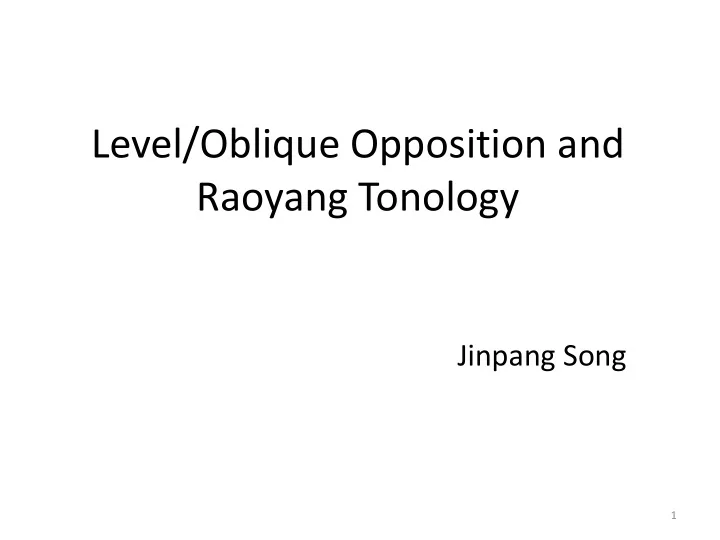

Level/Oblique Opposition and Raoyang Tonology Jinpang Song 1
Goals 1. Raoyang Tonal Structure Inadequacy of traditional tonal geometry The Theory of Contrastive Hierarchy 2. A Formal Analysis on Raoyang Tone Sandhi OT Account 2
Raoyang Dialect Map B2, the Language Atlas of China 3
Raoyang Tones: Phonetics Citation tone patterns and F0 curves: 4
Raoyang Tones: Phonetics Citation tone values: Two-tone sequence values: 5
Auditory Discrimination Findings (1) T1, T2 neutralization qing(T1)tian(T1) qing(T2)tian(T1) “blue sky” “cloudless sky” tian(T1)di(T4) tian(T2)di(T4) “heaven and earth” “farm” (2) T3, T4 neutralization mai(T3)fang(T2) mai(T4)fang(T2), “buy a house” “sell a house” mai(T3)mi(T3 mai(T4)mi(T3) “buy rice” “sell rice” 6
Informal Tone Sandhi Patterns 7
Phonology: Traditional Tonal Geometry Bao 1990 8
Raoyang Tones: Phonology 1. The predictability of register from sandhi position: the feature for register in every category is redundant. 2. The representation of four tones with the pitch feature: T4: fall [+raised, -raised] T2: high level [+raised, -raised] T1: low level [-raised, -raised] T3: rise [-raised, +raised] 9
Raoyang Tones: Phonology Underlying Representation: Tone Sandhi Patterns: 10
Level/Oblique (LO) Opposition in Raoyang T1 T2 T3 T4 11
Inadequacy of the Traditional Tonal Structure From Bao 1990 1. A node in feature geometry indicates a privative opposition by means of its existence(T3, T4) and non-existence(T1, T2). 2. Pitch features are dependent on the node of contour. If T1 and T2 lack this node, they also lack the pitch features. How would they be contrastive? 12
Inadequacy of the Traditional Tonal Structure From Bao 1990 3. Itinerary application of a specification rule is arbitrary. To account for the T3, T4 neutralization, a rule specifying opposite values for pitch 1 and pitch 2 has to be applied successively; a single application would result LO conversion. 13
Level/Oblique Conversion in Tianjin Trigger: contour dissimilation Target: LO conversion 14
A Possible Solution and Further Problems The level/oblique (LO) feature, instead of a contour node, is capable of equipollent opposition. The compatibility of contour node, pitch feature, register, and LO feature in one structure? 15
The Theory of Contrastive Hierarchy 1. Contrastive Specification: the featural content of a segment is determined by contrastiveness. 2. Feature hierarchy: specifications of features are not made at one stroke, but in a certain order. 3. How is the hierarchy decided: those at upper level of the hierarchy have a bigger scope and their re- specification may affect more phonemes. Dresher, 2003a, 2003b 16
Proposed Raoyang Tonal Structure 1. Two independent features of LO and pitch are present . 2. LO and the left pitch can predict the right pitch. 17
Raoyang Contrastive Hierarchy Regularity: Tone mapping is restricted to the pitch tier, while the LO feature remains constant. 18
OT Constraints: Faithfulness 1. Stability of the second tone: IDENT-IO-T-HEAD: Tones at the head of prosody do not change. 2. LO opposition: IDENT-IO-LO: LO feature does not change. 3. Stability of high pitch: IDENT-IO-[+raised]: High pitch value does not change. 19
OT Constraints: Markedness 4. The illegitimacy of T1.T1 and T3.T3 OCP-T: Same tones are not adjacent. *[-raised]: Low pitch is not allowed. 5. The illegitimacy of T1.T4 and T3.T2 *[-raised]/[+raised]: High pitch and low pitch are not adjacent. *[-oblique]/[+oblique]: Levelness and obliqueness are not adjacent. {*[-raised]/[+raised], *[-oblique]/[+oblique]} ADJ 20
OT Constraints Hierarchy 21
OT Tableau for T1+T1 22
OT Tableau for T2+T3 23
Conclusions 1. Analysis reveals LO Opposition in Raoyang, which is equipollent in nature. A contour node of privative nature does not capture it. 2. LO feature is claimed to be present. 3. Contrastive hierarchy of Raoyang tones: two features are organized into a hierarchy: LO>>pitch. 24
Remaining Questions 1. Application of the Contrastive Hierarchy Theory to a wide range of tone systems remains to be done. See Barrie 2007 for analysis on several cases. 2. Theoretical compatibility with the Underspecification Theory; Theoretical conflict with the UG Hypothesis and the Optimality Theory. 25
Thank you! songjinpang@hotmail.com 26
Recommend
More recommend